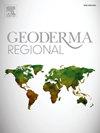On the importance of digital soil mapping scale for ecosystem service assessment and policy - A study involving soil sediments dynamic and direct aquifer recharge
IF 3.3
2区 农林科学
Q2 SOIL SCIENCE
引用次数: 0
Abstract
Soil is crucial for many ecosystem services. Among them, direct aquifer recharge and sediment dynamic have the soil as a fundamental basis for interpretations to improve territorial and environmental planning. This study assessed the importance of improving the scale (details) of soil maps and the impact it has on the correct interpretation and quantification of ecosystem services related to aquifer recharge and sediment dynamics. Fuzzy logic was applied to four watersheds from the Pontal do Paranapanema region, Brazil. Knowledge-based models were used to upscale soil maps, later validated and then adopted to derive information on direct water recharge and sediment dynamics. Effects of upscaling were evident when comparing the soil maps produced by fuzzy logic at low cost with the existing maps. Incorporating terrain attributes and legacy data effectively predicted soil spatial distribution in the studied watersheds, delivering overall accuracy and Kappa index values of 69–74 % and 0.51–0.63, respectively. Latossolos and Argissolos persist as the main soils in the watersheds, but their spatial distribution drastically changed. Another remarkable improvement on the soil maps by fuzzy logic was the detailed distinction of floodplain soils, which were not reported in previous maps. Aquifer discharge interpretations was severely affected by the soil maps scale. Trade-offs or synergies among ecosystem services were spatially detected since soil-landscape relations that foster water infiltration, storage, and direct aquifer recharge are those that also prevent soil loss (sediment retention). More detailed soil maps identified places where ecosystem services were more prominent in each watershed, showing the impact of using more detailed soil maps in this process. Knowledge-based process under the fuzzy logic approach allowed such maps upscaling at relatively low cost. Future studies should incorporate other environmental data (e.g., land use/land cover, relief variation, lithology, etc.) to further improve soil maps and, hence, the assessment of ecosystem services, supporting detailed interpretations and decision-making towards environmental sustainability.
数字土壤制图尺度对生态系统服务评价和政策的重要性——涉及土壤沉积物动态和含水层直接补给的研究
土壤对许多生态系统服务至关重要。其中,含水层直接补给和泥沙动态以土壤为基本依据进行解译,以改善国土和环境规划。本研究评估了改善土壤图的尺度(细节)的重要性,以及它对与含水层补给和泥沙动态有关的生态系统服务的正确解释和量化的影响。模糊逻辑应用于巴西Pontal do Paranapanema地区的四个流域。以知识为基础的模型被用于升级土壤地图,随后被验证,然后被用于获取直接补水和泥沙动态的信息。将模糊逻辑制作的低成本土壤图与现有土壤图进行比较,可以看出升尺度效应。结合地形属性和遗留数据有效预测了研究流域土壤空间分布,总体精度为69 ~ 74%,Kappa指数为0.51 ~ 0.63。拉托索洛土和阿基索洛土仍然是流域的主要土壤,但其空间分布发生了巨大变化。模糊逻辑对土壤图的另一个显著改进是对河漫滩土壤进行了详细的区分,这在以前的地图中是没有报道的。含水层流量解译受到土壤图尺度的严重影响。生态系统服务之间的权衡或协同作用在空间上被检测到,因为促进水渗透、储存和直接含水层补给的土壤-景观关系也可以防止土壤流失(沉积物滞留)。更详细的土壤图确定了每个流域中生态系统服务更突出的地方,显示了使用更详细的土壤图在这一过程中的影响。在模糊逻辑方法下的基于知识的过程使得这种地图以相对较低的成本进行升级。未来的研究应纳入其他环境数据(例如土地利用/土地覆盖、地形变化、岩性等),以进一步改进土壤图,从而评价生态系统服务,支持对环境可持续性的详细解释和决策。
本文章由计算机程序翻译,如有差异,请以英文原文为准。
求助全文
约1分钟内获得全文
求助全文
来源期刊

Geoderma Regional
Agricultural and Biological Sciences-Soil Science
CiteScore
6.10
自引率
7.30%
发文量
122
审稿时长
76 days
期刊介绍:
Global issues require studies and solutions on national and regional levels. Geoderma Regional focuses on studies that increase understanding and advance our scientific knowledge of soils in all regions of the world. The journal embraces every aspect of soil science and welcomes reviews of regional progress.
 求助内容:
求助内容: 应助结果提醒方式:
应助结果提醒方式:


